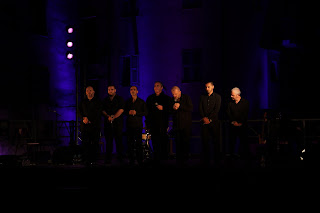




It’s strange that you can find only a small handful of works by Cézanne in Aix-en-Provence, where he lived and worked for so much of his life. Only seven small works are displayed at the Musée Granet. Many of his masterpieces were rescued by American and English collectors and can be seen in Philadelphia and London, for example. So to experience his works in Aix you need some imagination. And a good pair of walking shoes.
First, we decided to discover the object of his greatest passion, Montagne Ste-Victoire. He painted it 87 times. To best appreciate it, we decided to climb it, or at least to do a big hike in the vicinity, after a convivial picnic at its base. So there we were: Mom, who’s afraid of heights, 11-year-old Michael, who imagined we’d be scaling the mountain on hands and knees, Dad, Brad, Corinne and me. Michael did do his mountain-scaling business, to his great delight. Some of us actually completed the 8 km trek, which was one of the most satisfying hikes we’ve ever done, with breathtaking views at every turn. Next time, we’ll try to remember a hat, sunscreen, water, sunglasses and a camera.
The Atelier Cézanne, his workshop, involves another walk up the hill, this one just north of the old town of Aix-en-Provence. This was his last workplace, which he had especially built for himself in 1902 with floor-to-ceiling windows on the north and south sides. At the time, it was in the countryside, surrounded by olive trees and nature. He couldn’t actually see the mountain from there - that involved a hike further up the hill, with 20 kg of equipment on his back. The atelier is basically a snapshot of where and how he worked during his last four years. There are no actual works of art there, just some examples on a video screen. But all of his implements are on view, just as he left them, including his easels, his cloaks, hats, brush boxes, as well as some old tables holding an olive pot, a ginger pot, some skulls, a statue of cupid and lots of fruit. These were the original objects he painted as he explored colour, shapes and perspective. He worked there until his death in 1906.
When Michael stepped into the room, he asked, “Is this all there is? Just a room?” But there happened to be an English-speaking guide on hand who told stories and brought it all to life for him. I think he left with a real appreciation for Cézanne, his passion, his struggles and his creativity. He returned to the atelier the next day to choose two prints-- one of the Montagne Ste-Victoire, the other the famous portrait of two card players-- to take home as souvenirs.
But it’s possible Michael most appreciated his own role as tour guide in Aix-en-Provence. In very short order he familiarized himself with one of the cutest modes of transportation here, the Diabline, the Little Devil, which is kind of a little bubble on wheels that takes a handful of people at a time around the old town on three different routes. It’s not really a tourist thing, as locals use it frequently, especially when they’re laden down with kids or groceries. One of the stops is at the north edge of town, which eased our uphill hike to the atelier. It costs a mere 50 centimes for a whole tour, and if the drivers know your plan, you can make a transfer for free. Michael has taken all three routes several times now and has chosen his favourite. He will happily guide us, but ultimately knows his goal. As we rolled down Rue d’Italie he called out “arrête” in the middle of nowhere. We descended, and he marched directly into the candy store.
INGREDIENT OF THE WEEK: APPLES
So what did Mme. Cézanne do at the end of the day with all of that fruit that Paul painted?
It’s possible she might have sautéed it simply for dessert. She probably needed something to do to get her muscles moving again. During the day she proved to be his best model. She managed to sit, without budging, for hours on end while he painted her.
RECIPE OF THE WEEK: CARAMELIZED APPLES WITH ALMOND NOUGAT
The market is full of local apples at this time, including some fine organic russet apples from nearby Venelles. I learned how to make a variation of this dish at L’atelier des Chefs in Aix.
Start by making the nougat: Heat a half a cup of sugar in a saucepan until it has melted and turned a lovely toasty colour. Do not stir, just swirl it a bit. Dump in a handful of sliced almonds. Immediately spread the mixture onto a sheet of cooking paper with the help of a spatula, fold the paper over top, then pound it to a thin and flat consistency with a heavy pan. Let it rest to cool.
Peel and slice some apples, one per person. Again, dissolve some sugar in a frying pan along with a spoonful of water. When it is liquid and not too brown, add a knob of butter, then add the sliced apples. Sprinkle on a bit of cinnamon if you like. Turn the apples around in the pan until they are tender, around five minutes. You can do this in advance and re-warm them just before serving.
Divide the apples among the serving dishes. Break up the nougat into chunks and place them in and around the apples decoratively. Add a small dollop of crème fraîche or whipped cream if you wish.
A la prochaine,
Andrea











